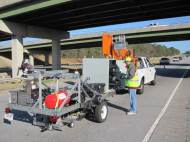Automated system able to detect cracks in pavement and seal them
 Researchers from Georgia Tech Research Institute (GTRI) recently published new results from a project started back in 2003. They developed a prototype of an automated system able to detect cracks in pavement and seal them. The system is able to detect cracks smaller than 3 mm (one-eighth-inch) wide and efficiently fill cracks from a vehicle moving at a speed of 4.8 km/h (3 mph), however, the system still needs to be improved before it is used in road maintenance.
Researchers from Georgia Tech Research Institute (GTRI) recently published new results from a project started back in 2003. They developed a prototype of an automated system able to detect cracks in pavement and seal them. The system is able to detect cracks smaller than 3 mm (one-eighth-inch) wide and efficiently fill cracks from a vehicle moving at a speed of 4.8 km/h (3 mph), however, the system still needs to be improved before it is used in road maintenance.
“Our prototype system has proved in many ways that a commercial-scale automated crack sealing system is viable”, said Jonathan Holmes, the GTRI research engineer who currently leads the project. “We demonstrated solutions to technical challenges – including the high-speed firing of nozzles, automated crack detection and navigation – in a real-time, limited-scale system.”
The operation requires only one worker to drive the vehicle pulling the trailer where all of the equipment is mounted. The prototype detects the cracks with a stereo camera and light-emitting diodes (LEDs) of two different colors (red and green). LEDs illuminate the road in directions parallel and perpendicular to the road, while the stereo camera simultaneously takes pictures of both directions and sends the images to the filtering algorithms GTRI researchers developed.
The software creates a “crack map” specifying the location and shape of any cracks shown in the images within 100 milliseconds after the image is received. The crack detection algorithm was tested on more than 100,000 images of cracks on state roads, and it was able to correctly identify more than 83 percent of the cracks. Not too shabby, but it will need to be improved before the full-scale system becomes used by transportation departments.
“Our crack detection algorithm was limited because we used a vision-based system, which was confounded by regions of high contrast caused by features other than pavement cracks, including dark stains in the pavement, lane stripes, raised-pavement markers, crack sealant and debris”, said Holmes. “A full-scale system may require a fusion of multiple imaging sensors, such as a 3-D laser scanning system.”
If there are cracks found on an image, the master controller instructs valves to open and repair the damage with the sealant. To fill longitudinal cracks, a single dispensing nozzle capable of continuous operation was attached to a linear servo axis. The transverse sealant distribution system consisted of 12 nozzles spaced evenly across 30 cm (1 foot). The transverse and diagonal distribution prototype was intended to represent one module that could be replicated and joined together to service a full-width roadway lane.
Although the prototype system proved to be a successful proof-of-concept in multiple tests, there are several problems which need to be solved. Aside increasing detection ability of the system, there are changes needed to be made in the way the sealant is applied in longitudinal and transverse distribution systems as well.
Once fully developed and optimized, the automated crack sealing system could increase the level of safety for the involved workers, it would require less operators and increase the efficiency in terms of amount of roadway being covered each day.









You could say they are paving the way for these automated systems. To bad there’s a crack in their detection.